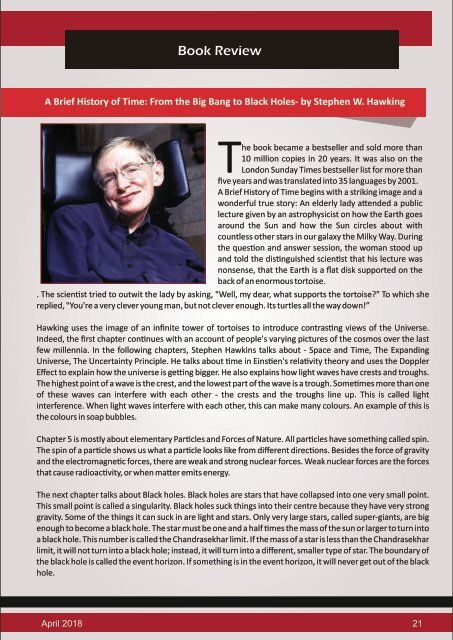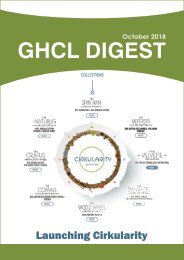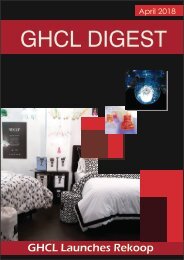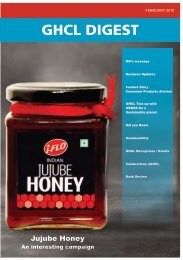GHCL Digest-APRIL 2018
GHCL Digest-APRIL 2018
GHCL Digest-APRIL 2018
You also want an ePaper? Increase the reach of your titles
YUMPU automatically turns print PDFs into web optimized ePapers that Google loves.
Book Review<br />
A Brief History of Time: From the Big Bang to Black Holes- by Stephen W. Hawking<br />
he book became a bestseller and sold more than<br />
T10 million copies in 20 years. It was also on the<br />
London Sunday Times bestseller list for more than<br />
five years and was translated into 35 languages by 2001.<br />
A Brief History of Time begins with a striking image and a<br />
wonderful true story: An elderly lady a ended a public<br />
lecture given by an astrophysicist on how the Earth goes<br />
around the Sun and how the Sun circles about with<br />
countless other stars in our galaxy the Milky Way. During<br />
the ques on and answer session, the woman stood up<br />
and told the dis nguished scien st that his lecture was<br />
nonsense, that the Earth is a flat disk supported on the<br />
back of an enormous tortoise.<br />
. The scien st tried to outwit the lady by asking, "Well, my dear, what supports the tortoise?" To which she<br />
replied, "You're a very clever young man, but not clever enough. Its turtles all the way down!”<br />
Hawking uses the image of an infinite tower of tortoises to introduce contras ng views of the Universe.<br />
Indeed, the first chapter con nues with an account of people's varying pictures of the cosmos over the last<br />
few millennia. In the following chapters, Stephen Hawkins talks about - Space and Time, The Expanding<br />
Universe, The Uncertainty Principle. He talks about me in Eins en's rela vity theory and uses the Doppler<br />
Effect to explain how the universe is ge ng bigger. He also explains how light waves have crests and troughs.<br />
The highest point of a wave is the crest, and the lowest part of the wave is a trough. Some mes more than one<br />
of these waves can interfere with each other - the crests and the troughs line up. This is called light<br />
interference. When light waves interfere with each other, this can make many colours. An example of this is<br />
the colours in soap bubbles.<br />
Chapter 5 is mostly about elementary Par cles and Forces of Nature. All par cles have something called spin.<br />
The spin of a par cle shows us what a par cle looks like from different direc ons. Besides the force of gravity<br />
and the electromagne c forces, there are weak and strong nuclear forces. Weak nuclear forces are the forces<br />
that cause radioac vity, or when ma er emits energy.<br />
The next chapter talks about Black holes. Black holes are stars that have collapsed into one very small point.<br />
This small point is called a singularity. Black holes suck things into their centre because they have very strong<br />
gravity. Some of the things it can suck in are light and stars. Only very large stars, called super-giants, are big<br />
enough to become a black hole. The star must be one and a half mes the mass of the sun or larger to turn into<br />
a black hole. This number is called the Chandrasekhar limit. If the mass of a star is less than the Chandrasekhar<br />
limit, it will not turn into a black hole; instead, it will turn into a different, smaller type of star. The boundary of<br />
the black hole is called the event horizon. If something is in the event horizon, it will never get out of the black<br />
hole.<br />
April <strong>2018</strong> 21











